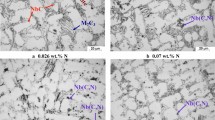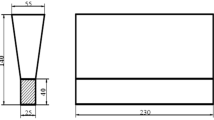Conclusions
The increase in the wear resistance of gray cast irong after low-temperature cyaniding in molten urea and soda is due to the saturation of the surface with nitrogen and carbon. A substantial increase in the wear resistance is obtained for cast iron containing aluminum, which results in the formation of nonbrittle ε phase and high microhardness of the base metal in the zone saturated with nitrogen below the carbonitride layer.
Similar content being viewed by others
Literature Cited
R. Jack. Proc. Roy. Soc.,195-A (1949).
K. Jack, Nature,158, No. 4002 (1946).
V. K. Thomas, Zavod. Lab., No. 4 (1965).
Additional information
All-Union Scientific-Research Institute of Textile and Light Machine Construction. Translated from Metallovedenie i Termicheskaya Obrabotka Metallov, No. 1, pp. 52–53, January, 1972.




